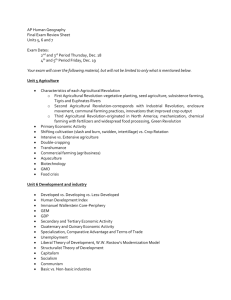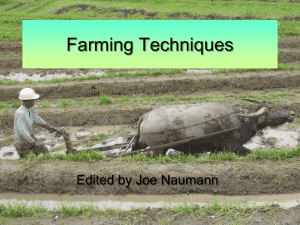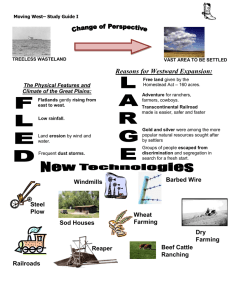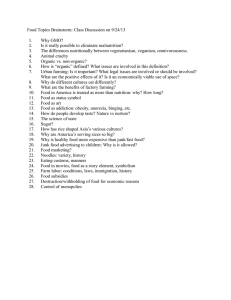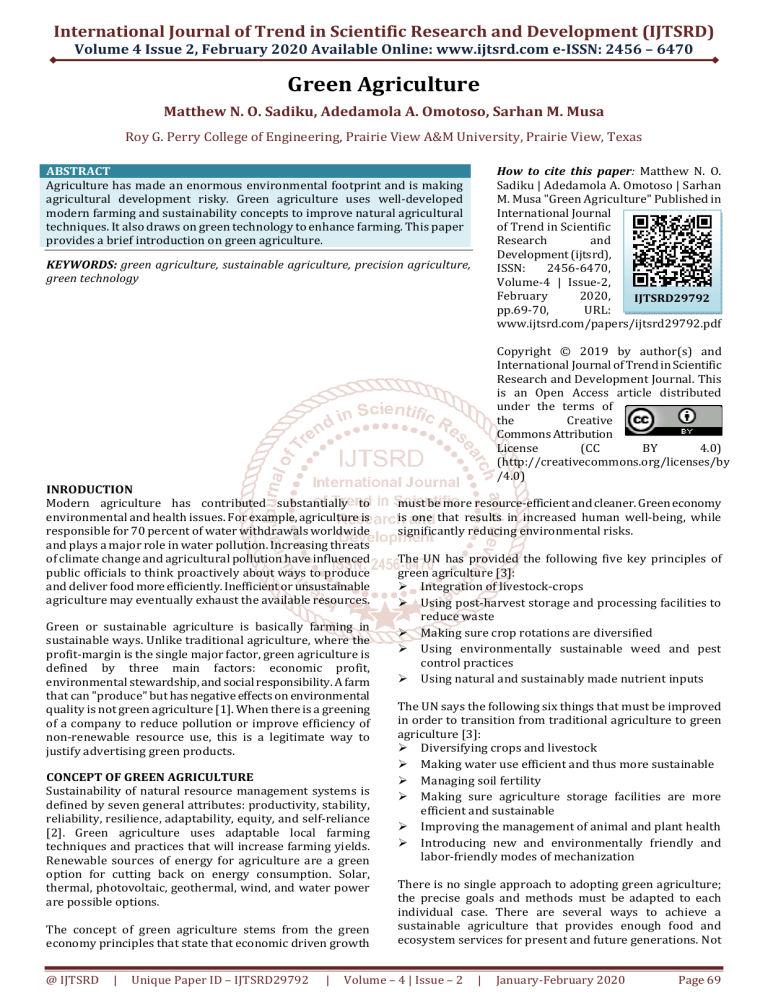
International Journal of Trend in Scientific Research and Development (IJTSRD) Volume 4 Issue 2, February 2020 Available Online: www.ijtsrd.com e-ISSN: 2456 – 6470 Green Agriculture Matthew N. O. Sadiku, Adedamola A. Omotoso, Sarhan M. Musa Roy G. Perry College of Engineering, Prairie View A&M University, Prairie View, Texas How to cite this paper: Matthew N. O. Sadiku | Adedamola A. Omotoso | Sarhan M. Musa "Green Agriculture" Published in International Journal of Trend in Scientific Research and Development (ijtsrd), ISSN: 2456-6470, Volume-4 | Issue-2, February 2020, IJTSRD29792 pp.69-70, URL: www.ijtsrd.com/papers/ijtsrd29792.pdf ABSTRACT Agriculture has made an enormous environmental footprint and is making agricultural development risky. Green agriculture uses well-developed modern farming and sustainability concepts to improve natural agricultural techniques. It also draws on green technology to enhance farming. This paper provides a brief introduction on green agriculture. KEYWORDS: green agriculture, sustainable agriculture, precision agriculture, green technology Copyright © 2019 by author(s) and International Journal of Trend in Scientific Research and Development Journal. This is an Open Access article distributed under the terms of the Creative Commons Attribution License (CC BY 4.0) (http://creativecommons.org/licenses/by /4.0) INRODUCTION Modern agriculture has contributed substantially to environmental and health issues. For example, agriculture is responsible for 70 percent of water withdrawals worldwide and plays a major role in water pollution. Increasing threats of climate change and agricultural pollution have influenced public officials to think proactively about ways to produce and deliver food more efficiently. Inefficient or unsustainable agriculture may eventually exhaust the available resources. Green or sustainable agriculture is basically farming in sustainable ways. Unlike traditional agriculture, where the profit-margin is the single major factor, green agriculture is defined by three main factors: economic profit, environmental stewardship, and social responsibility. A farm that can "produce” but has negative effects on environmental quality is not green agriculture [1]. When there is a greening of a company to reduce pollution or improve efficiency of non-renewable resource use, this is a legitimate way to justify advertising green products. CONCEPT OF GREEN AGRICULTURE Sustainability of natural resource management systems is defined by seven general attributes: productivity, stability, reliability, resilience, adaptability, equity, and self-reliance [2]. Green agriculture uses adaptable local farming techniques and practices that will increase farming yields. Renewable sources of energy for agriculture are a green option for cutting back on energy consumption. Solar, thermal, photovoltaic, geothermal, wind, and water power are possible options. The concept of green agriculture stems from the green economy principles that state that economic driven growth @ IJTSRD | Unique Paper ID – IJTSRD29792 | must be more resource-efficient and cleaner. Green economy is one that results in increased human well-being, while significantly reducing environmental risks. The UN has provided the following five key principles of green agriculture [3]: Integration of livestock-crops Using post-harvest storage and processing facilities to reduce waste Making sure crop rotations are diversified Using environmentally sustainable weed and pest control practices Using natural and sustainably made nutrient inputs The UN says the following six things that must be improved in order to transition from traditional agriculture to green agriculture [3]: Diversifying crops and livestock Making water use efficient and thus more sustainable Managing soil fertility Making sure agriculture storage facilities are more efficient and sustainable Improving the management of animal and plant health Introducing new and environmentally friendly and labor-friendly modes of mechanization There is no single approach to adopting green agriculture; the precise goals and methods must be adapted to each individual case. There are several ways to achieve a sustainable agriculture that provides enough food and ecosystem services for present and future generations. Not Volume – 4 | Issue – 2 | January-February 2020 Page 69 International Journal of Trend in Scientific Research and Development (IJTSRD) @ www.ijtsrd.com eISSN: 2456-6470 all geographic regions lend themselves readily to green agriculture. Greenhouses have also been used to provide green agriculture to arid climates. APPLICATIONS Greening of agriculture is far more than a simple study of the marketplace and expanding the advertising process. Green agriculture affects many economic sectors. The applications that are considered here are only typical. Each application pursues triple bottom line–economics, environmental agenda, social decisions– and impacts the greening of agriculture and the food system. Green Agriculture Products Supply Chain: This chain makes the concept of "green, health and environmental protection" throughout the agriculture products supply chain. The green agriculture products supply chain management can be divided into green purchasing, green production, green manufacturing, green logistics, green marketing, green consumption, and green recycling. All links are connected into a whole [4]. Green Jobs: Agriculture has always been a productive economic sector and will continue to be in future times. Agriculture is a labor intensive and specific measures shall be put in place such as insurance coverage for natural disasters. Green agriculture and green jobs play a pivotal role in fostering social development and sustainability. The transition to a more sustainable agriculture delivers more employment opportunities such as green jobs [5]. Organic Farming: Organic farming is the type of farming in which crops develop from natural resources having the complete nutritive value and preventing the crop/plants from the pests. It is a sustainable approach to food production system, an alternative to ecologically unsound practices of conventional farming. Those who started organic farming considered themselves as improving the environment, producing safe and healthy food, and generally filling an important role in society. With the strict rules that govern organic farming, such as prohibition of application of chemical pesticides and fertilizers, most organic farms are greener than most conventional farms [6]. Consumers are increasingly interested in fully organic food and they are willing to pay higher prices for it than for conventionally produced food. Nanotechnology: This is a new rapidly evolving field with applications covering various areas such as medicine and agriculture. Aspects related to productivity, soil health, water security, and food quality maintenance during storage and distribution can be strongly impacted through nanotechnological interventions. Successful implementation of nanotechnological interventions requires a judicious mix of science, policy, and technologies. In agriculture, nanotechnology can help the agro-food sector in the sustainable production as well as in reducing the environmental impact of agricultural operations. Nanoparticles play a major role in plant growth and productivity. However, the application of nanoparticles in agriculture is still in the early stages [7]. @ IJTSRD | Unique Paper ID – IJTSRD29792 | BENEFITS AND CHALLENGES Around the world, evidence is mounting to support sustainable forms of agricultural production as viable alternatives to conventional farming practices. Adopting green agriculture results in many localized benefits. Green agriculture products with no pollution, high quality, high nutritional value are more and more appreciated by the consumers. Green agriculture enhances the well-being of rural populations and poverty reduction in developing countries. Some major challenges to the sustainability of the world‘s agriculture are [8]: (i) Pollution, (ii) Biodiversity loss, (iii) Soil Degradation/ Nutrient loss/Erosion, (iv) Water Scarcity/ Salinity, (v) Carbon Foot-print, (vi) Natural Resource Depletion . Simply making a technology available does not mean it will be adopted. Barriers to adopting new technologies can limit their effectiveness. CONCLUSION Agriculture affects the natural environment in providing for management of land and water resources. Agricultural systems are constantly changing with time. Green agriculture incorporates profit, environmental stewardship, fairness, health, business, and familial aspects on a farm setting. Using green technologies and farming practices will allow us to continue the tradition of agriculture without harming the planet. Green agriculture is the future of agriculture. More information on green agriculture can be found in the book [9]. REFERENCES [1] “Sustainable agriculture,” Wikipedia, the free encyclopedia, https://en.wikipedia.org/wiki/Sustainable_agriculture [2] P. Koohafkan, M. A. Altieri, and E. H. Gimenez, “Green Agriculture: foundations for biodiverse, resilient and productive agricultural systems,” International Journal of Agricultural Sustainability, vol.10, no. 1, 2012, pp. 6175. [3] “What is green agriculture?” http://www.greencityplumber.ca/blog/going-greentips/green-agriculture/ [4] B. Zhao and J. Liu, “Research on the model construction of modern green agriculture products supply chain,” IEEE International Symposium on IT in Medicine and Education, Dec. 2011, pp. 173-176. [5] A. Bianco, “Green jobs and policy measures for a sustainable agriculture,” Agriculture and Agricultural Science Procedia, vol. 8, 2016, pp. 346 – 352. [6] C. Francis et al., “Greening of agriculture,” Journal of Crop Improvement, vol. 19, no. 1-2, 2007, pp. 193-220. [7] H. Mahawar and R. Prasann.“Prospecting the interactions of nanoparticles with beneficial microorganisms for developing green technologies for agriculture,” Environmental Nanotechnology, Monitoring & Management, vol. 10, 2018, pp. 477-485. [8] A. Hall and K. Dorai, “The greening of agriculture: Agricultural innovation and sustainable growth,” Unknown Source. [9] A. Kahn, Green Agriculture Newer Technologies. Jaipur, India: Agrotech Press, 2014. Volume – 4 | Issue – 2 | January-February 2020 Page 70

